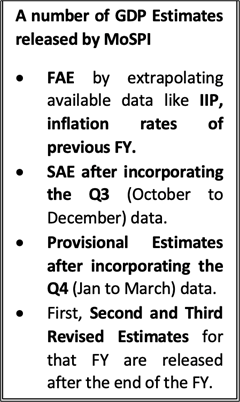Friday, 4th March 2022
Health Star Rating for Packaged Goods
In News
Food Safety and Standards Authority of India (FSSAI) is expected to introduce health star rating for packaged goods.
About the News
- The Indian Institute of Management Ahmedabad (IIM-A) had recently released a report on the impact of front-of-the-pack labelling for packaged and processed foods.
- The study endorsed the health star rating (HSR) format as the best suited method to Indians to help them choose healthier packaged food items under a new policy on Front of Packaging Labelling (FoPL).
- The official health star rating (HSR) will be the first such in India aimed at guiding consumers to opt for healthy food as our country is burdened with lifestyle diseases.


HSR and the Need for such a Rating
- What is it? The HSR format ranks a packaged food item based on salt, sugar, and fat content and the rating will be printed on the front of the package.
- Why do we need it?
- Back-of-Package (BOP) Nutrient Info in India: In India, packaged food only has back-of-package (BOP) nutrient information in detail but no FoPL. This allows consumers not to read the information available at the back of the packaged food item.
- Huge NCD Burden: India has a huge burden of non-communicable diseases that contributes to around 87 million (60%) of all deaths in a year and thus HSR will encourage people to make healthy choices which will bring a transformational change in the society.
- Category of food item that will have HSR: All packaged food items or processed food such as chips, biscuits, namkeen, sweets and chocolates, meat nuggets etc will have the HSR label. However, milk and its products such as chenna and ghee are exempted from the declaration of front of pack labelling.
- Implementation of the rating: HSR format will be implemented from 2023 on voluntary basis and there will be a transition period of four years for making it mandatory.
For articles related to this topic, refer:
https://edukemy.com/current-affairs/gazette/2021-09-13/food-safety-labels-on-the-front-side-fssai
https://edukemy.com/current-affairs/gazette/2021-09-27/sustainable-food-systems
https://edukemy.com/current-affairs/gazette/2021-06-16/fortified-food
https://edukemy.com/current-affairs/gazette/2021-12-24/eat-right-initiative
Source:
- FSSAI to introduce health star rating for packaged goods
- The food safety measures that you can’t afford to ignore
Image source:
Insurance of Kudankalam Nuclear Power Plant
In News
New India Assurance (NIA) is set to insure additional two units of the Kudankulam Nuclear Power Plant (KKNP).
About the News
- NIA, which has provided the property covers for the first two units of the plant with the participation of state-owned GIC Re, had won the Nuclear Power Corporation of India Ltd (NPCIL) mandate for insuring two more units of the KKNPP after a competitive bidding last November.
- NIA will soon complete the placement of property cover for units three and four of KKNPP, which is likely to be executed with the participation of major global reinsurers.
- Going by existing reinsurance norms, in order of preference, NIA has to first approach GIC Re which has the first “right of refusal” for any reinsurance business in India.
- Once GIC refuses fully or partly, NIA — following the order of preference — can approach foreign reinsurance branches (FRBs) in India, reinsurers who are present in GIFT City and lastly cross-border reinsurers registered with IRDAI.

What is Reinsurance?
- It may be described as "insurance of insurance companies” where multiple insurance companies share risk by purchasing insurance policies from other insurers to limit their own total loss in case of disaster.
- By spreading risk, an Insurance company takes on clients whose coverage would be too great of a burden for the single insurance company to handle alone.
- When reinsurance occurs, the premium paid by the insured is typically shared by all of the insurance companies involved.
- Insurance covers for nuclear plants are purely reinsurance driven, like aviation insurance, where the primary insurer reinsures over 90 per cent of the high value cover with large sum assured, and more than one global reinsurer.
Insurance of Nuclear Power Plants
- A nuclear plant has two covers: a property cover and a liability cover.
- The liability cover for a nuclear plant is always covered by the Nuclear Pool, formed by the general insurers and managed by state owned reinsurer GIC Re.
About KKNP
- The Kudankulam Nuclear Power Plant (NPP) is to be India’s largest nuclear power plant.
- The plans entail constructing six units of 1,000 megawatts (MW) each, of which two units have already been completed.
- Units 1 and 2 started generation in 2016, while units 3, 4, 5 and 6 are at different stages of completion.
- The project is seen as a milestone for Indo-Russia cooperation as it is being built by Rosatom’s subsidiary Atomstroyexport, along with NPCIL.
- Rosatom has stated that it sees no disruption in the execution of the KKNP due to the ongoing conflict between Russia and Ukraine.
- The placement of Kudankulam insurance has to be completed soon, as the reinsurance market has shown a hardening tendency in view of the Russian invasion of Ukraine which has started impacting the reinsurance rates.
For Articles related to this topic, refer:
https://edukemy.com/current-affairs/gazette/2021-12-23/indias-nuclear-energy-potential
https://edukemy.com/current-affairs/kosmos/2021-10-30/nuclear-energy-in-india-need-and-prospects
https://edukemy.com/current-affairs/kosmos/2022-01-22/the-need-for-energy-diversification-in-india
https://edukemy.com/current-affairs/gazette/2022-02-14/nuclear-fusion-reactors
Sources:
Economic impact of Ukrainian crisis
In News
India can expect rise in inflation due to Russian invasion of Ukraine
About the News
- Ongoing geopolitical crisis due to Russia-Ukraine war is expected to push India’s import bills topping $600 billion in present fiscal, pushing up inflation in the economy.
- The impact will be felt more on inflation, a widening current account deficit and a falling rupee.
- The economic impact will not be confined to oil only and will extends as much to higher for items such as mineral oils and gas, gems and jewellery, edible oils and fertilisers.
- The challenges that Ukraine will present in the coming days are going to be vastly different from those in the aftermath of Corona
What is the major impact of Ukrainian crisis on global trade?
- Cascading effects: The current Russian invasion of Ukraine unlike previous wars in Iraq and Libya or sanctions against Iran is having an impact not just on energy prices as the effects of shipping disruptions through the Black and Azov Seas.
- Russian banks being cut off from the international payments system, are extending even to the global agri-commodities markets.
- Supply disruptions:
- Disruptions in exports from Russia: Russia is world’s third biggest oil (after the US and Saudi Arabia) and the second biggest natural gas (after the US) producer, besides the 3 coal exporter (behind Australia and Indonesia). It is also the second largest exporter of wheat.
- Impact on exports from Ukraine: Ukraine is world’s 4th largest exporter of wheat It is also world’s third largest exporter of corn/maize, 2nd largest exporters of sunflower oil.
- Surge in commodity Prices:
- Crude oil: Russia’s war on Ukraine has driven up Brent crude to $110-15/barrel and international coal prices to unprecedented $440/tonne levels.
- Edible oils: War has led to prices of vegetable oils and oilseeds skyrocketing including sunflower and soyabean. Palm oil in Malaysia has hit all-time-highs, even scaling 7,000 ringgits-per-tonne levels briefly in the past few days.
How has Ukraine crisis impacted India?
- Higher demand for Wheat: Skyrocketing global prices have made Indian wheat exports very competitive with India already shipped out 5.04 mt of the cereal in April-December 2021. Wheat are now being delivered at Rs 2,400-2,450 per quintal, as against Rs 2,100 or so hardly recently.
- Threat to Food security: A lot of wheat from western and central India may end up getting exported rather than in the Food Corporation of India’s godowns and, in turn, putting pressure on public stocks:
- Inflation: Increase in prices of commodities especially crude oil is expected to push retail and wholesale inflation upwards in near future.
- Flight of capital: Conflict can trigger capital flight from stock markets, which can result in weakening of the rupee.
- Agri-commodities: Brent at $110-115/barrel is also helping lift the prices of cotton (because of synthetic fibres becoming costlier) and agri-commodities that can be diverted for production of ethanol (sugar and corn) or bio-diesel (palm and soyabean oil).
- Fertilizers: The ongoing Black Sea tensions have virtually choked import of fertilizers as India imports nearly a third came from Belarus (0.92 mt) and Russia (0.71 mt).
- Merchandise: Loss of revenue for India as it has merchandise trade with Ukraine at $2.35 billion and with Russia at $8-11 billion during FY18-FY21
For Articles related to this topic, refer:
https://edukemy.com/current-affairs/gazette/2022-02-25/crude-oil-prices-in-india-amid-ukraine-crisis
https://edukemy.com/current-affairs/gazette/2022-02-28/russia-ukraine-a-backgrounderq
https://edukemy.com/current-affairs/gazette/2022-01-31/ukraine-russia-crisis
Sources:
First Asian Games
On March 4, 1951 first edition of the Asian Games started in New Delhi. This first Asian Games was an Indian initiative, which was intrinsically linked to the larger Indian self-image of being a major Asian power and the Nehruvian idea of India’s centrality in a new global order. The Games were officially opened by Indian President Rajendra Prasad at the Dhyan Chand National Stadium. Japan topped the medal table with 24 gold, 21 silver and 15 bronze medals.

Sources:
Relevance of Fundamental Duties in India’s Democracy
In News
The Supreme Court has asked the Centre and the states to respond to a plea seeking the enforcement of the Fundamental Duties through well-defined comprehensive laws.
What are Fundamental Duties?
- Fundamental Duties of an Indian citizen are listed in Article 51A, under Part IV A of the constitution. Just like the Directive Principles enumerate the duties of the State, the Fundamental Duties guide the citizens to act responsibly while exercising their Fundamental Rights.
- However, they were not included in the original text of the constitution. The Fundamental Duties of citizens were added to the Constitution by the 42nd Amendment in 1976, upon the recommendations of the Swaran Singh Committee that was constituted by the Government. The Committee suggested that steps needed to be taken to ensure that the individual did not overlook his duties while in exercise of his Fundamental Rights.
- It is a moral obligation of every citizen to perform in duties to promote a spirit of patriotism and uphold the unity of India. These were inspired by the constitution of erstwhile USSR.
Scope of Fundamental Duties
Neither there is a direct provision in the Constitution for the enforcement of these duties nor is there any legal sanction in order to prevent violation of these duties. The following facts signify the importance of fundamental duties:
- A person should respect the fundamental rights and duties equally because in any case, if the court comes to know that a person who wants his/her rights to be enforced is careless about his/her duties then the court will not be lenient in his/her case.
- Any ambiguous statute can be interpreted with the help of fundamental duties.
- The court can consider the law reasonable if it gives effect to any of the fundamental duties. In this way, the court can save such law from being declared as unconstitutional.
The features of Fundamental duties are as follows
- Both moral and civic duties have been laid down under the fundamental duties, like, “the Indian citizens should not only cherish the noble ideas that lead to the freedom struggle but they should also respect the Constitution, the National Flag and National Anthem”.
- Fundamental rights can be applied to foreigners also but the fundamental duties are only restricted to the Indians citizens.
- The fundamental duties are not enforceable in nature. No legal sanction can be enforced by the government in case of their violation.
Fundamental Duties and Democracy
- Fundamental duties, despite their non-enforceability, are more essential for a democratic state like India. A democratic state cannot survive unless its people are able to take an active role in government and accept responsibility for the country's best interests.
- Fundamental duties are intended to serve as a constant reminder to every citizen that while the constitution specifically conferred on them certain Fundamental Rights, it also requires citizens to observe certain basic norms of democratic conduct and democratic behaviour because rights and duties are co-relative.
- The chapter on Fundamental Rights in the Constitution itself recognises the essence of duties. One pertains to freedom of speech but Clause 2 to 6 of Article 19 permits reasonable restrictions on the exercise of such rights in the interest of the sovereignty and integrity of India, and the security of the state, public order, decency and morality. This implies that while exercising one’s rights must remember one’s duties towards these constitutional and democratic concepts.
Why were they introduced?
- During the Emergency of 1975 to 1977, a committee under Sardar Swarn Singh was set up, which recommended the inclusion of a separate chapter on Fundamental duties in the constitution to stress that while enjoying their rights, citizens should be conscious of the fact that they have responsibilities towards the fellow citizens and the State.
- The government accepted the recommendations and ten Fundamental Duties were added through the 42nd Constitutional Amendment Act of 1976.
- The inclusion of Fundamental Duties brought our Constitution in line with article 29 (1) of the Universal Declaration of Human Rights and with provisions in several modern Constitutions of other countries. The concept of Fundamental duties was taken from the USSR.
- Originally ten fundamental duties were listed. Later on, by virtue of 86th Constitution the Amendment in year 2002, 11th duty was added.
Arguments for enforcement of the Fundamental Duties
- Many nations across the world have transformed into developed economies by embodying the principles of “responsible citizenship” through Fundamental Duties — all the responsibilities and duties that citizens of a nation should exercise and respect. The United States of America is a classic example in this respect. The Citizens’ Almanac, issued by the US Citizenship and Immigration Services, details the responsibilities of its citizens — a copy of this document is given to every person on becoming a citizen of the country.
- Rights and duties are interrelated and one cannot be divorced from the other. The exercise of only rights will lead to anarchy and the performance of only duties will lead to tyranny.
- Non observance of duties by a few obstructs the enjoyment of Rights of others. The failure to observe the duties hamper the rights of other persons like safety of women at workplace, protection of environment, etc.
- As pointed out by the Verma committee, many FDs are being implemented through legal provisions. Making them enforceable will bring uniformity and reasonableness.
- In the M.C. Mehta case, the Supreme court introduced compulsory education to protect the environment, which is a Fundamental Duty under Article 51 A (g). This will increase the avenues to clean environment, strengthening the Right to Life.
- Increasing instances of custodial deaths (Tamil Nadu) and misbehaviour by public authorities call for enforcing these duties for the officials through service rules and code of conduct.
Arguments against the enforcement of Fundamental Duties
- The constitution is made to protect the rights of the people from being eroded by the State rather than to burden them with responsibilities of the State. No other liberal democracy has added Fundamental Duties in their Constitution (except Japan).
- Phrases like ‘noble ideals’, ‘composite culture’ etc. are open to multiple interpretations. At times, the provisions are vague and ambiguous and may lead to misuse by the government to curb the Freedom of speech and liberties of the people. This has been seen with Section 66 A of the IT act and the laws on sedition.
- Making the FDs legally enforceable will allow the government to further the agenda of the political party in power.
- Will embolden groups which take laws in their own hands to protect the culture like cow vigilantism.
Conclusion:
Fundamental duties after all the scrutiny and examination they have been subjected to, deserve a fair share of appreciation as well. These fundamental duties form a breathing inseparable organ of the Constitution, the supreme law of the land and the world’s longest written Constitution. In current times, it has become increasingly important to inculcate the civic obligations among Indian citizens. This object can be achieved by adding new duties to the existing list of duties under the Constitution while simultaneously laying emphasis on the performance of the existing ones.
Excessive emphasis on exercise of fundamental rights and their ever-increasing scope as interpreted by the judiciary has made it almost necessary for the codification relating to civic obligations. Thus, fundamental duties serve as a core of a mutual coherence and welfare State.
“The moral value of Fundamental Duties would be not to smother rights but to establish a democratic balance by making the people conscious of their duties equally as they are conscious of their rights”. – PM Indira Gandhi
For articles related to this topic, refer:
https://edukemy.com/current-affairs/gazette/2021-10-12/the-role-of-police-during-the-pandemic
Question: Critically analyze the need for enforceability of Fundamental Duties in India
Sources:
- Indian Express - Explained: What are the Fundamental duties…
- The Hindu - SC to examine plea to enforce Fundamental Duties through laws
- Indian Express – Plea in SC seeks law to ensure citizens fulfill duties
- Constitution Day and Fundamental Duties:
- Need to remember our fundamental duties as we remember our fundamental rights:
- We the People, We the Citizen:
- Fundamental duties:
- Importance Of Fundamental Duties And Role Of Citizens In Upholding Sovereignty, Unity And Integrity Of India:
- India since independence – Bipan Chandra
Kaliyattam Festival
This is image from the Kaliyattam Festival, celebrated in Kerala. The annual kaliyattam festival, also known as Thalapoli Utsavam is celebrated as a huge event by the devotees. Kaliyatta Kavu is a famous temple dedicated to Ammancheri Amma (Mother Goddess). The annual festival is celebrated in the Malayalam month of Edavam. The festival begins on the first Monday of Edavam. Devotees carry effigies as procession to the temple accompanied by percussion instruments. Conceived as divine forms, these effigies are brought from far places. After the ritualistic circumambulation the effigies will be destroyed near the temples. In the evening there will be Thalapoli.
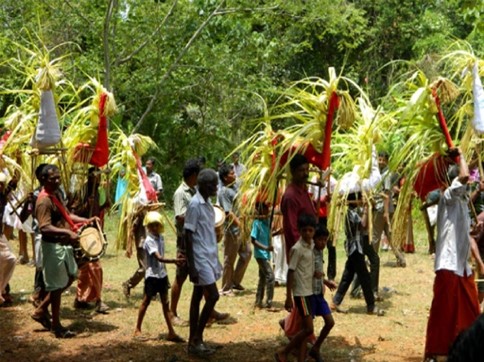
Source:
SIMBA
- Context: An innovative solution, dubbed SIMBA for the management and conservation of Asiatic lions has been developed recently by the Gujarat Forest Department.
- Software with Intelligent Marking Based identification of Asiatic lions (SIMBA) is a photo-identification software, specifically designed to distinguish patterns or marks on the specimen.
- Asiatic lions (endemic to the Gir landscape of Gujarat) have unique whisker spots on either side of their muzzle and these precise patterns are highly variable and do not change over time.
- The software extracts this uniqueness from the photograph and can cluster similar patterns or marks within the embedding space of the machine learning.
- It uses the photograph to match a point-pattern for pairwise comparisons that automates the individual identification based on the variability in the individual’s whisker spot pattern, the presence of scars on the face, notches on the ears etc.
- The software has been developed by Hyderabad-based “teliolabs” and can be used to create a library of data/database on the Asiatic lions with a unique identification number/ name.
- Asiatic Lions are slightly smaller than African Lions and are categorized as “endangered” in the IUCN Red list and are listed in Schedule-I of Wildlife (Protection) Act, 1972.
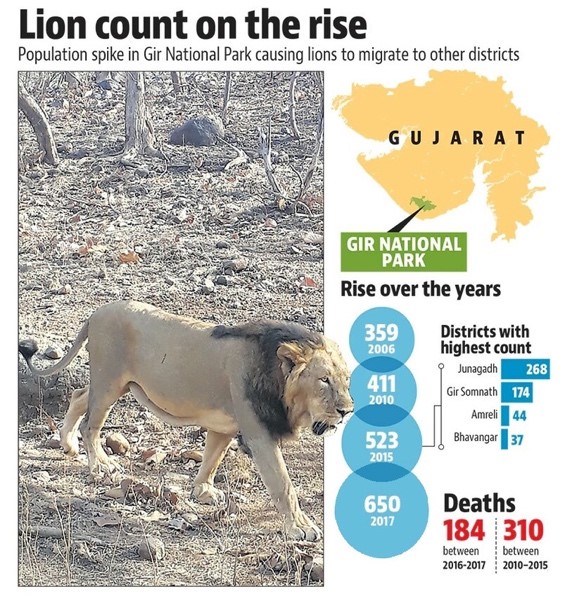
Source:
Image source:
Nomads’ Welfare Scheme
- Context: The Ministry of Social Justice has launched a scheme for economic empowerment of nomadic tribes in Jammu and Kashmir, Ladakh and Himachal Pradesh.
- The scheme will be implemented at an approximate cost of Rs 200 crore over a period of five years to empower the denotified (DN), semi-notified (SNT) and notified (NT) sections of the nomadic tribes of J&K, Himachal and Ladakh regions.
- The nomadic tribes are the most neglected, marginalised and economically and socially deprived communities in our country who hardly have any access to land or home of their own.
- They generally inhabit the forest and grazing lands for their livelihood and residential use and have strong ecological connections.
- They run their livelihood by carving out intricate ecological niches for their survival and thus any change in ecology and environment seriously affect their livelihood options.
- They constitute sizeable chunk of population in the Himalayan regions, including the Baddis and Ban Gujjars in HP and the Gujjar-Bakerwals in J&K and Ladakh.
- Under the scheme, coaching, health insurance, livelihood initiatives at community level and financial assistance for construction of houses will be provided to such communities.
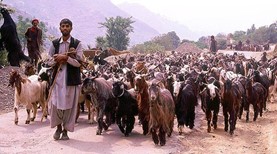
Source:
Image source:
Dugong Reserve in Palk Bay
- Context: The Tamil Nadu government has recently decided to establish a conservation reserve for the dugong sea cow.
- The reserve would be established in the Gulf of Mannar, Palk Bay between India and Sri Lanka.
- Dugong (Dugong dugon) also called as ‘Sea Cow’ is the only existing species of herbivorous mammal belonging to Order Sirenia.
- They are an important part of the marine ecosystemand are found to inhabit Gulf of Mannar, PalkBay, Gulf of Kutch and Andaman and Nicobar islands.
- Once abundant in Indian waters, Dugong population has now reduced to about only 200 individuals mainly due to accidental entanglement, ocean floor trawling, habitat fragmentation, pollution, illegal fishing, unsustainable hunting or poaching and tourism.
- They are categorized as Vulnerable on the IUCN Red List and listed as Schedule I animal under the Wildlife (Protection) Act, 1972.
- In order to conserve and manage the declining populations of dugong in India, the Ministry of Environment, Forests and Climate Change has constituted a ‘Task Force for Conservation of Dugongs’.

Source:
- Better late than never: Experts on Tamil Nadu’s decision to go ahead with dugong reserve in Palk Bay
- Dugong
Image source:
Foreign Exchange Swap
- Context: Recently, the RBI announced $5 billion worth of sell-buy foreign exchange swaps with a tenure of two years.
- A sell-buy swap involves two transactions. The RBI will sell dollars in the spot market immediately and simultaneously enter into a contract to buy these back two years later from the forward market. When a central bank sells dollars, it gets back rupees and vice versa.
- Through a sell-buy swap, the RBI will end up absorbing rupees and infusing a similar amount two years hence. In other words, rupee liquidity in the system diminishes on an immediate basis but may increase two years later when the RBI takes delivery of dollars under the forward contract.
- This operation sits well in the current context of surplus rupee liquidity and the exchange rate needing support amid global volatility.
- In the current context of volatile global currency markets, the rupee has been fairly resilient. However, as pressures mount because of ongoing geopolitical tensions involving Russia and Ukraine, emerging market currencies are expected to weaken and the rupee won’t be an outlier.

Source:
Urban development: A not-so-smart story: HBL
Essence: Although the Housing and Urban Affairs Ministry's budget has expanded in recent years, urban regions continue to suffer because of poor programme execution and cities' insufficient financial and technical competence. Schemes like Pradhan Mantri Awas Yojana (PMAU) have failed to focus on the target population. Consistent increases in the operating cost ratio, on the other hand, point to Delhi Metro's poor operational performance. Irregularities in the Smart Cities Mission's implementation owing to the frequent cancellation of projects after finalising bids have been discovered.
Article further mentions that Urban Local Bodies (ULBs) in India are among the weakest in the world in terms of resource raising capabilities and financial autonomy. The author suggests for a high-level committee comprised of urban planners, urban economists, and institutions to offer recommendations on urban sector policies, capacity building, planning, implementation, and governance.
Why should you read this article?
- To have a better understanding of the difficulties surrounding India's different development schemes, notwithstanding increased budgetary allocations.
- To learn what measures may be made to remedy the problem.
Source:
Forced multiplier: Will public capex crowd in private investment?: FE
Essence: Fiscal thrust on capital expenditure has raised expectations of increase in private investment and faster economic growth in the post-covid period. However, we should temper our expectations because public investment-based growth strategy has not delivered a consistent result in the past. In fact, in FY18, GDP growth declined even after high capital spending.
A detailed examination of past policy outcomes and related factors is essential to formulate policies for the present and future with realistic hopes.
Why should you read this article?
- To know that the approach of increasing public expenditure to boost growth may have its own limitations.
- To understand some of the factors which might make a public investment approach fail.
Source:
CEPA fostering economic security between India and the UAE- ORF
Essence: The editorial speaks about the opportune moment for the finalization of India-UAE CEPA. The present times offer scope of increased trade potential due to reduction of tariff, alternative to trading with China, avenues for employment and investment destination. Eyeing bilateral trade of $100bn within next 5 years, the strategy looks at harnessing the demand potential of GCC countries, which collectively happens to be India’s largest trading block. Trading competencies will increase in textile, jewel, automobiles, pharmaceuticals, movement of skilled persons, etc. Investments to India will pour into the fields of energy security, food security, hospitality, other incubator business, etc.
The scope for renewed partnership expands with the formation of Abraham Accords between Israel and UAE/Bahrain and the new quad in the region.
Why should you read this article?
- To understand the advantages of new India-UAE CEPA.
- To know the potential of trade in middle east region.
Source:
Upholding the right of a deceased farmer
Background
- Farmer suicide is one of the pressing problems in India, which needs immediate redressal.
- A school teacher from Telangana is working towards addressing the key factors of farmers suicide.
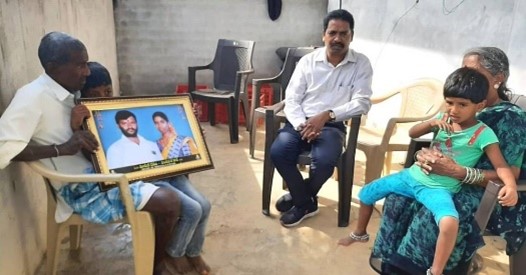
Selfless dedication for welfare of farmer families
- Puli Raju, who is a government school teacher by profession in the Siddipet district of Telangana, saw his family struggle due to agricultural hardships and mental agony.
- Raju began work in 2002, and meticulously documented such incidents in his region. He traced the victims and visited the aggrieved families to offer them support by whatever means he could.
- Soon he learnt about the increasing rate of farmers suicide, but missing registration of deaths due to the definition of a farmer set by the law.
- As the suicides were not registered, the families could not get compensation provided by the government.
- Till today he has reached 2,500 households across the state to offer mental, psychological and financial support.
- He is even helping farmers to switch to a more sustainable mode of cultivation, to pull them out of the vicious cycle of debt.
Quote: “Cultivators of the earth are the most valuable citizens. They are the most vigorous, the most independent, the most virtuous, and they are tied to their country and wedded to its liberty and interests by the most lasting bonds.”― Thomas Jefferson
Source:
Share the article
Get Latest Updates on Offers, Event dates, and free Mentorship sessions.

Get in touch with our Expert Academic Counsellors 👋
FAQs
UPSC Daily Current Affairs focuses on learning current events on a daily basis. An aspirant needs to study regular and updated information about current events, news, and relevant topics that are important for UPSC aspirants. It covers national and international affairs, government policies, socio-economic issues, science and technology advancements, and more.
UPSC Daily Current Affairs provides aspirants with a concise and comprehensive overview of the latest happenings and developments across various fields. It helps aspirants stay updated with current affairs and provides them with valuable insights and analysis, which are essential for answering questions in the UPSC examinations. It enhances their knowledge, analytical skills, and ability to connect current affairs with the UPSC syllabus.
UPSC Daily Current Affairs covers a wide range of topics, including politics, economics, science and technology, environment, social issues, governance, international relations, and more. It offers news summaries, in-depth analyses, editorials, opinion pieces, and relevant study materials. It also provides practice questions and quizzes to help aspirants test their understanding of current affairs.
Edukemy's UPSC Daily Current Affairs can be accessed through:
- UPSC Daily Current Affairs can be accessed through Current Affairs tab at the top of the Main Page of Edukemy.
- Edukemy Mobile app: The Daily Current Affairs can also be access through Edukemy Mobile App.
- Social media: Follow Edukemy’s official social media accounts or pages that provide UPSC Daily Current Affairs updates, including Facebook, Twitter, or Telegram channels.


